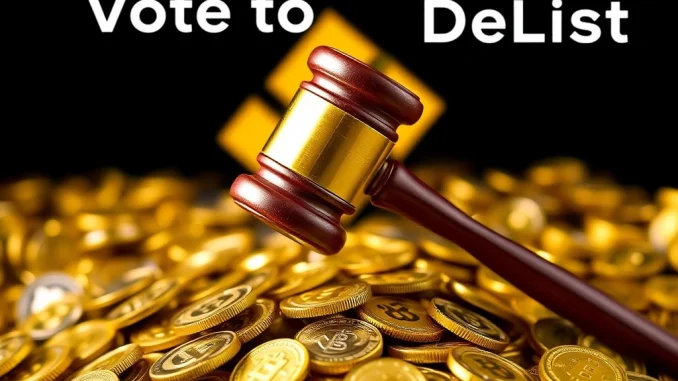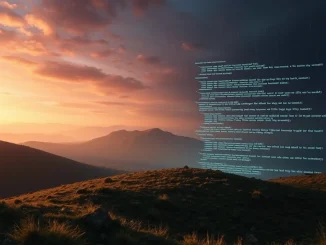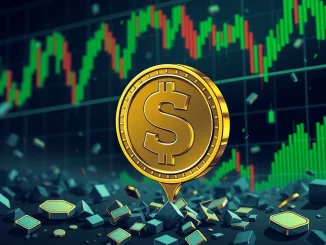
The crypto world is once again buzzing with anticipation and, for some, anxiety, as Binance, the leading global cryptocurrency exchange, has announced the second batch of tokens under its ‘Vote to Delist’ program. This significant development has put 17 digital assets in the spotlight, signaling potential changes in the exchange’s offerings and impacting the broader crypto market. Are your holdings among the tokens at risk? Let’s dive into the details of this crucial announcement and understand what it means for you.
What is Binance’s ‘Vote to Delist’ Program and Why Does it Matter?
Binance’s ‘Vote to Delist’ program is an initiative designed to ensure the quality and integrity of the tokens listed on its platform. In essence, it’s a community-driven approach to maintaining a healthy and dynamic trading environment. But why is this program so important, and why should crypto enthusiasts pay close attention?
- Quality Control: In the rapidly evolving world of cryptocurrencies, projects and tokens emerge and sometimes fade away just as quickly. The ‘Vote to Delist’ program acts as a quality control mechanism, helping to remove tokens that may no longer meet Binance’s standards for various reasons, such as low trading volume, compromised security, or lack of project development.
- Protecting Users: Delisting underperforming or problematic tokens can protect users from potential risks associated with these assets. It signals to the community that Binance is proactive in safeguarding its users’ interests.
- Platform Optimization: By periodically reviewing and potentially delisting tokens, Binance can optimize its platform, focusing on assets that are more actively traded and contribute to a vibrant ecosystem.
- Community Engagement: The ‘vote’ aspect of the program involves the community, giving Binance users a voice in shaping the exchange’s token offerings. This fosters a sense of ownership and participation within the Binance ecosystem.
In short, the ‘Vote to Delist’ program is a crucial tool for Binance to maintain a high-quality exchange, protect its users, and adapt to the ever-changing landscape of the cryptocurrency market. It’s a process that can have significant implications for token holders and the crypto space as a whole.
Which Tokens are in the Second Batch of Binance’s Crypto Delisting Vote?
Now, let’s get to the heart of the matter: which tokens are facing the potential chopping block in this second round of Binance’s ‘Vote to Delist’? Here is the list of the 17 tokens that have been added to the delisting consideration:
- FTT (FTX Token)
- ZEC (Zcash)
- JASMY (JasmyCoin)
- STPT (Standard Tokenization Protocol)
- ARK (Ark)
- ARDR (Ardor)
- GPS (GPS Token)
- MBL (MovieBloc)
- PERP (Perpetual Protocol)
- NKN (NKN)
- WING (Wing Finance)
- LTO (LTO Network)
- FLM (Flamingo Finance)
- BSW (Biswap)
- ALPACA (Alpaca Finance)
- VOXEL (Voxies)
- PDA (PDA)
This diverse list includes tokens from various sectors of the crypto market, ranging from DeFi and privacy coins to gaming and infrastructure projects. The inclusion of prominent names like FTT and ZEC alongside lesser-known tokens underscores the breadth and seriousness of Binance’s review process.
FTT Delisting: What Does it Mean for the Market?
Perhaps the most recognizable name on the list is FTT, the native token of the now-collapsed FTX exchange. While FTX’s downfall is well-documented, the potential FTT delisting from Binance still carries weight and raises several questions:
- Symbolic Significance: Delisting FTT would serve as a final nail in the coffin for the FTX era, marking a clear separation from the exchange’s troubled past. It reinforces the industry’s move to distance itself from the FTX saga.
- Limited Direct Impact: Given FTX’s bankruptcy and the token’s already diminished prominence, the direct market impact of FTT delisting might be limited. FTT’s trading volume and market cap are significantly lower than before the FTX collapse.
- Sentiment Indicator: However, the delisting could still affect market sentiment. It could be interpreted as a reminder of the risks associated with centralized exchanges and the importance of due diligence in the crypto space.
For FTT holders, the potential delisting from Binance adds another layer of complexity to an already challenging situation. It’s crucial to monitor Binance’s official announcements and understand the timeline and implications for FTT trading on the platform.
JASMY Delisting and ZEC Delisting: Privacy and IoT Tokens Under Scrutiny
The inclusion of JASMY (JasmyCoin), a project focused on the Internet of Things (IoT), and ZEC (Zcash), a privacy-focused cryptocurrency, in the crypto delisting vote is also noteworthy. What could be the reasons behind these tokens being considered for delisting?
JASMY (JasmyCoin):
- Project Development: One possible reason for JASMY’s inclusion could be related to the project’s development progress and adoption rate. Binance might be evaluating whether JasmyCoin has achieved sufficient traction and real-world use cases to justify its continued listing.
- Trading Volume: Low trading volume can also be a factor. If JASMY’s trading activity on Binance has been consistently low, it might be considered for delisting to optimize platform resources.
- Community Engagement: The level of community engagement and project updates from the Jasmy team could also be under review. Active projects with strong community support are generally favored.
ZEC (Zcash):
- Regulatory Scrutiny: Privacy coins like Zcash have faced increased regulatory scrutiny in various jurisdictions due to concerns about their potential use in illicit activities. This regulatory pressure could be a factor in Binance’s decision to consider ZEC delisting.
- Adoption and Usage: While Zcash is a well-established privacy coin, its adoption and usage in mainstream crypto applications might be compared to other cryptocurrencies on Binance. If Zcash’s usage within the Binance ecosystem is deemed insufficient, it could be considered for delisting.
- Technological Advancements: The pace of technological advancements in the privacy coin space and Zcash’s competitiveness within this niche could also be factors in Binance’s evaluation.
The potential delisting of JASMY and ZEC highlights the diverse factors that Binance considers when evaluating tokens, ranging from project fundamentals and trading activity to regulatory considerations and technological competitiveness.
What Happens Next in the Vote to Delist Process?
With these 17 tokens now listed for the second batch of the ‘Vote to Delist’ program, what are the next steps, and what can token holders expect?
- Community Vote: While the announcement is titled ‘Vote to Delist,’ it’s important to clarify that the actual voting mechanism might not be a direct on-chain vote by Binance users for each token. Instead, ‘vote’ likely refers to Binance’s internal evaluation process, which may consider community sentiment and various metrics. The exact details of the ‘vote’ process for this second batch will be crucial to monitor in Binance’s official communications.
- Review Period: Binance will likely conduct a review period, during which they will assess various factors related to these tokens, potentially including trading volume, liquidity, project updates, regulatory compliance, and community feedback.
- Announcement of Results: Following the review period, Binance will announce its decision regarding which tokens, if any, will be delisted. This announcement will be critical for token holders to understand the final outcome.
- Delisting Timeline: If any tokens are indeed delisted, Binance will provide a timeline for the delisting process, including the dates for deposit closures, trading cessation, and withdrawal deadlines. It’s crucial for holders of potentially delisted tokens to pay close attention to these timelines to manage their assets accordingly.
For users holding any of the 17 tokens listed, the most important action is to stay informed. Monitor Binance’s official announcement channels, social media, and news updates for further details on the ‘Vote to Delist’ process and the final decisions.
Navigating Crypto Delisting: Actionable Insights for Token Holders
Token delisting, while sometimes concerning, is a part of the crypto ecosystem’s natural evolution. Here are some actionable insights for token holders to navigate these situations effectively:
- Stay Informed: Regularly monitor announcements from exchanges and project teams regarding token listings and potential delistings. Information is your best tool in these situations.
- Diversification: Diversifying your crypto portfolio across multiple assets can mitigate the impact of any single token delisting. Avoid concentrating your holdings in just a few potentially risky or volatile assets.
- Understand Delisting Risks: Be aware that delisting is a possibility for any cryptocurrency. Factors like low trading volume, project inactivity, regulatory issues, or security concerns can all lead to delisting.
- Manage Your Holdings Proactively: If you hold tokens that are at risk of delisting, consider taking proactive steps. This might include transferring your tokens to a different exchange that still supports them, or exploring alternative options depending on your investment strategy.
- Community Engagement: For projects you believe in, actively participate in the community and support the project’s development. Strong community support can sometimes influence exchange decisions and project longevity.
Conclusion: A Critical Moment for These 17 Tokens and the Binance Ecosystem
Binance’s second batch of ‘Vote to Delist’ projects represents a critical moment for the 17 tokens involved and for the broader Binance ecosystem. The potential crypto delisting of tokens like FTT, ZEC, and JASMY highlights the ongoing evolution and refinement of the cryptocurrency exchange landscape. For token holders, this announcement serves as an urgent reminder to stay vigilant, informed, and proactive in managing their crypto assets. As the ‘Vote to Delist’ process unfolds, the crypto community will be watching closely to see which tokens will remain on Binance and what this means for the future of these projects and the exchange itself. Keep your eyes peeled for further updates and be prepared to adapt to the evolving crypto environment.



